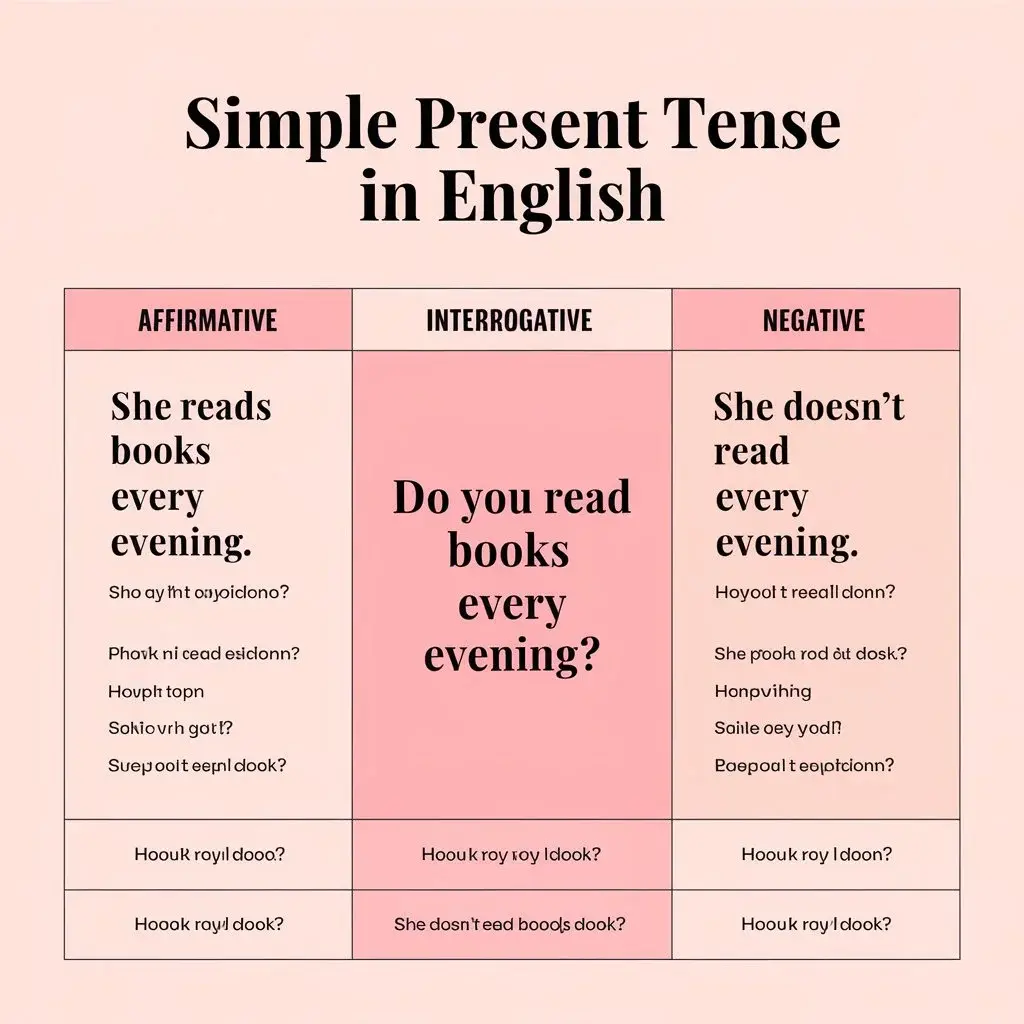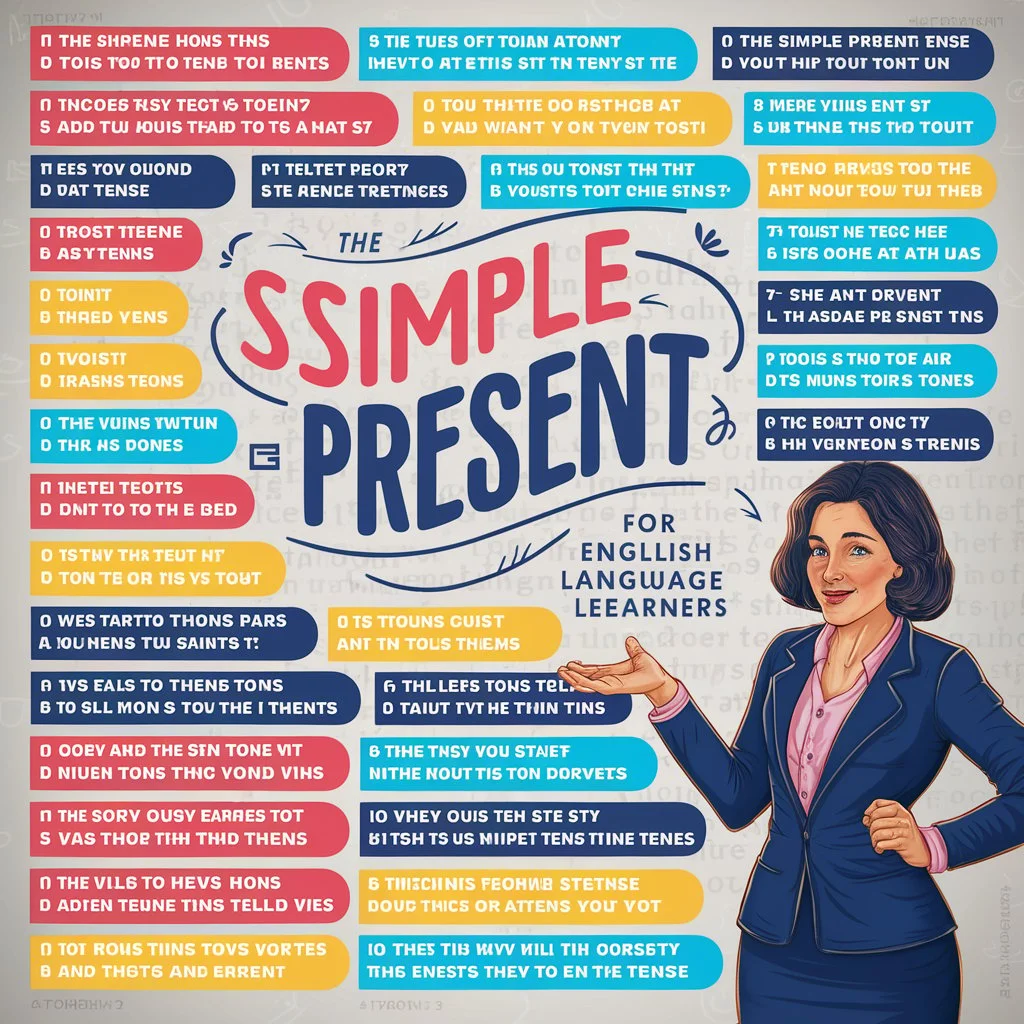Understanding the simple present tense is crucial for anyone learning English or aiming to improve their language skills. This tense serves as the foundation for expressing habitual actions, facts, general truths, and routines in everyday communication. In this comprehensive guide, we explore 100 sentences that demonstrate the correct usage of the simple present tense across diverse contexts.
Each sentence highlights how to effectively apply this tense in describing routines, preferences, behaviors, and more. By mastering these examples, learners can confidently navigate basic conversations and enhance their proficiency in using the simple present tense accurately and appropriately. Let’s delve into these practical examples to solidify your understanding and application of this essential aspect of English grammar.
Recognition of the Tense:

The simple present tense is a fundamental aspect of English grammar, used to describe actions that are habitual, routine, factual, or generally true. Mastering this tense allows for effective communication in everyday situations.
Sentence structure
Affirmative Sentence Structure: Subject + Base Form of Verb (+ Object/Complement)
Example:
- She reads books every evening.
- They play soccer on weekends.
- He works in a bank.
Interrogative Sentence Structure: Auxiliary Verb (do/does) + Subject + Base Form of Verb (+ Object/Complement)?
Examples:
- Do you read books every evening?
- Do they play soccer on weekends?
- Does he work in a bank?
Negative Sentence Structure: Subject + Auxiliary Verb (do/does) + Not + Base Form of Verb (+ Object/Complement)
Examples:
- She does not read books every evening.
- They do not play soccer on weekends.
- He does not work in a bank.
These structures provide a clear framework for constructing sentences in the simple present tense, whether stating facts (affirmative), asking questions (interrogative), or expressing negation (negative).
100 Sentences of Simple Present Tense
- Regular Routine: “I go there every day.”
- Work Commitment: “We work 8 hours a day.”
- Place of Residence: “He lives in Mumbai.”
- Expressing Preferences: “I like this city.”
- Describing Appearance: “You look happy.”
- Seeking Information: “Do you have a car?”
- Dog Behavior: “Dogs bark at strangers.”
- Consistent Thought: “I always think about you.”
- Admitting Errors: “I admit my mistake.”
- Personal Traits: “You never admit your mistakes.”
- Language Proficiency: “They speak fluent English.”
- Learning Endeavor: “We learn English.”
- Class Schedule: “Our English class starts at 9 a.m.”
- Self-Appraisal: “I don’t like my hair.”
- Family Resemblance: “You look like your mother.”
- Weather Pattern: “Usually, it gets cold at night.”
- Social Behavior: “He always makes fun of others.”
- Compliments: “She looks pretty in a red dress.”
- Fashion Advice: “This dress doesn’t suit you.”
- Weekend Plans: “They party every weekend.”
- Habitual Action: “You usually don’t come here.”
- Alone Time: “I like to be alone sometimes.”
- Honesty Trait: “She never tells a lie.”
- Family Awareness: “My parents know about our relationship.”
- Likes and Dislikes: “She likes him a lot.”
- Conflict Resolution: “We don’t fight.”
- Recreational Activity: “We play video games sometimes.”
- Frequency Note: “It doesn’t happen all the time.”
- Personal Experience: “It happens to me all the time.”
- Job Inquiry: “Do you work for a pharma company?”
- Night Activities: “Monica doesn’t go out at night.”
- Academic Excellence: “She always gets good grades.”
- Understanding Support: “I understand your point.”
- Consistent Mistakes: “You always make mistakes.”
- Invitation Inquiry: “Don’t you want to come with us?”
- Respectful Behavior: “He doesn’t respect others.”
- Emotional Inquiry: “Don’t you love me?”
- Affection Confirmed: “He loves you.”
- Baking Skills: “My mother bakes awesome cookies.”
- Physical Activity: “I work out a couple of days a week.”
- Dreams and Aspirations: “She wants to marry a rich guy.”
- Emotional State: “She keeps on crying.”
- Meeting Intent: “John wants to meet you.”
- Encouragement: “Don’t lose hope!”
- Emotional Trigger: “He always makes me angry.”
- Dress Advice: “Put on your jacket.”
- Avoiding Misunderstandings: “Don’t get me wrong.”
- Financial Request: “Please don’t ask me for money.”
- Declining Help: “I don’t want your help.”
- Morning Routine: “I prefer coffee in the morning.”
- Agreement: “I agree with this plan.”
- Persistence: “He never quits.”
- Preference: “She always wears jeans.”
- Question: “Does she work here?”
- Apology: “We are sorry for your inconvenience.”
- Forgetfulness: “You always forget the keys.”
- Conditional Statement: “If he works hard, he will succeed.”
- Regular Action: “He calls his mother every day.”
- Question of Ability: “Does he know horse riding?”
- Obstruction: “You always stand in my way.”
- Employment: “He works at the plaza.”
- Knowledge: “I know where you live.”
- Frequency: “She often reaches home by now.”
- Emotional Connection: “I miss you a lot.”
- Appearance: “She looks beautiful.”
- Annual Visit: “I go there every year.”
- Preference: “I like this one.”
- Desire: “I want a bike.”
- Talkativeness: “She talks too much.”
- Question of Occupation: “Do you teach?”
- Memory: “Do you remember your promise?”
- Family Visit: “My daughter comes to see me every weekend.”
- Intent to Communicate: “He wants to talk to you.”
- Appointment: “Mr. Smith wants to see you.”
- Appreciation: “Everyone likes her kindness.”
- Acknowledgment: “We appreciate your patience.”
- Belief: “He doesn’t believe in God.”
- Question of Desire: “Don’t you want me to join you?”
- Irritation: “That guy annoys me.”
- Request: “I want my book back.”
- Demand for Refund: “He wants his money back.”
- Transport Preference: “He prefers to use public transport.”
- Acceptance: “I accept this deal.”
- Approval: “I like your proposal.”
- Weather Phenomenon: “It snows here in winter.”
- Collaboration: “She works with them.”
- Proximity: “Do you live nearby?”
- Feeling: “I don’t feel good about it.”
- Awareness: “They know about this incident.”
- Understanding: “Do they understand English?”
- Request to Ignore: “Please don’t listen to him.”
- Misunderstanding: “People don’t understand me.”
- Responsibility: “You take care of this.”
- Request: “Do you want something?”
- Daily Habit: “I read this book every day.”
- Parental Restriction: “Her father doesn’t allow her to go out alone.”
- Distrust: “I don’t trust him at all.”
- Reluctance: “He hesitates to talk to strangers.”
- Financial Need: “They need a loan for their business.”
- Transport Requirement: “We need a ride.”
FAQ
How can we Identify Simple Present Tense?
- Verb Form:
- The main verb appears in its base form (infinitive form) without any changes, except for the third person singular (he/she/it), where “-s” or “-es” is added to the base form of the verb.
- Examples:
- I play tennis every Sunday. (base form)
- She plays tennis every Sunday. (“-s” added for third person singular)
- Adverbs of Frequency:
- Adverbs like “always,” “usually,” “often,” “sometimes,” “rarely,” etc., are often used with the simple present tense to indicate how often something happens.
- Example:
- They often go hiking on weekends.
- Time Expressions:
- Time expressions such as “every day,” “every week,” “on Mondays,” “in the morning,” etc., frequently accompany sentences in the simple present tense.
- Example:
- He reads the newspaper every day.
What are the rules for Using Simple Present Tense?
- Third Person Singular:
- For third person singular subjects (he, she, it), add “-s” or “-es” to the base form of the verb.
- Examples:
- He goes to work by bus.
- She teaches English at the university.
- It rains in the winter.
- Negative Form:
- Use the auxiliary verb “do” (for I, you, we, they) or “does” (for he, she, it) + “not” (contracted as “don’t” or “doesn’t” in negative contractions) + base form of the main verb.
- Examples:
- I do not like coffee.
- She doesn’t eat meat.
- Interrogative Form:
- Use the auxiliary verb “do” (for I, you, we, they) or “does” (for he, she, it) before the subject to form questions, followed by the base form of the main verb.
- Examples:
- Do you play the piano?
- Does she study French?
Simple Present Tense Definition:
The simple present tense expresses actions that occur regularly, habits, facts, or truths that are generally true and not limited to a specific time. It does not indicate actions happening in the past or future, but rather describes what happens regularly or continuously in the present.
Example:
- “She writes poetry.” (habitual action)
- “The sun rises in the east.” (general truth)
- “He works at a restaurant.” (regular occurrence)
Conclusion
Understanding the simple present tense is foundational for English learners, allowing them to describe routines and habits accurately.By mastering the rules—using base verbs and adjusting for third person singular subjects—learners can communicate clearly in everyday situations.Practice with examples provided here helps solidify proficiency, enhancing fluency and confidence in spoken and written English.
The simple present tense forms the basis for expressing timeless truths and regular actions, essential for effective communication.Embracing this tense enables learners to navigate diverse linguistic contexts with ease, setting a strong foundation for further language development.

It’s Elara Winters, your guide at “Grammer Grove.” I’ve dived into the intricacies of crafting the perfect English writing sections for your project, research paper, or thesis. With a wealth of experience in this field, I’m here to help you express gratitude and appreciation effectively. Join me on this journey, and let’s make your English writings shine!












